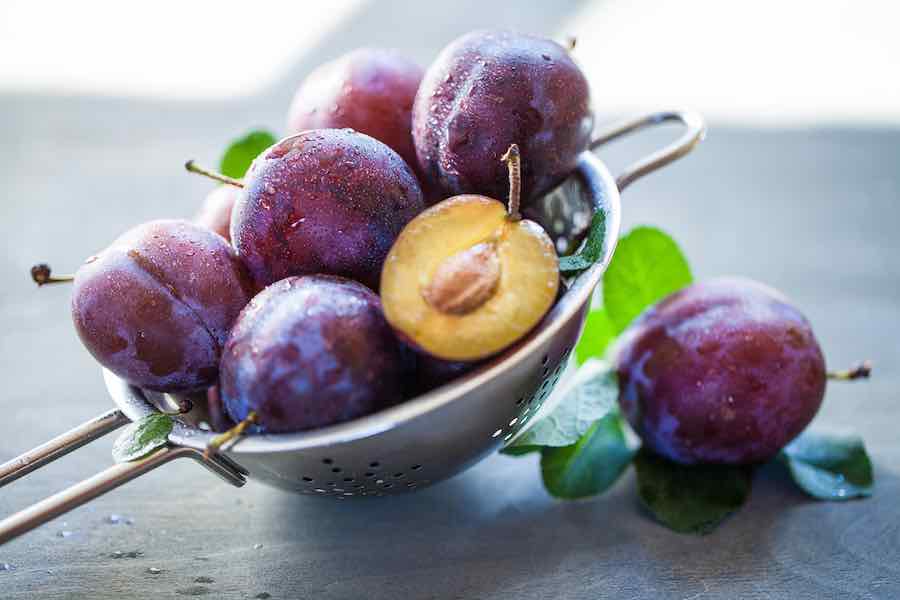Did you know that plums are not only delicious but that fgdsgfdsgfdsgdfshere are some amazing health benefits of eating plums?
Plums are actually from the same family as apricots, peaches, and nectarines, but that’s where the similarities end. In fact, plums offer much more variety than any of the other stone-fruits in their family tree. When it comes to size and color, plums can be purple, yellow, orange, and red and can be large or small.

Thousands of years ago, plums were first grown in China. From there, they were eventually brought to Japan, the US and certain areas of Europe. Flash forward to today and there are over 2,000 plum varieties grown throughout the globe.
Now that you know a bit of history behind plums, let’s dive into the health benefits of eating plums (spoiler alert: there’s a lot!).
Health Benefits of Eating Plums

Vitamin C found in plums helps your body build muscle, form blood vessels, recover, and is beneficial for your eyes as well. Here are other health benefits associated with plums:
1. Lower Blood Pressure
According to a study in 2010, participants who drank prune juice and ate prunes had lower blood pressure than the prune-less control group.
2. Protection Against Cell Damage/Cancer
Anthocyanins – the reddish-blue pigment in plums – can help remove harmful free radicals. This, in turn, helps to protect your body from cancer and cell damage.
3. Ideal For Weight Loss
Looking to drop some weight and slim down your waistline? Researchers at the University of Liverpool divided 100 overweight subjects into two groups; one group ate prunes every day over a 12 week period, and the control group did not. On average, those in the prune group lost 4.4 lbs and an inch off their waistline.
4. Low Calories
At 30 calories, a small plum isn’t just a great snack, it also helps satisfy cravings for sweets. With this in mind, plums can be ideal for those who are on a diet or want to cut back on their calorie intake.

5. Great For Bone Health
According to a study conducted by Oklahoma State and Florida State Universities Research, subjects who ate prunes and took vitamin D and calcium supplements had significantly improved bone density in their spine and forearms than the group who consumed dried apples and took the same supplements.
6. Effective for Constipation Relief
Plums are filled with dietary fiber and when dried, the resulting prunes are well known to aid in constipation relief. In fact, a recent study found that a group of 51 people (all adults) who were all dealing with constipation saw relief from their symptoms after eating plums.
7. Improves Memory & Brain Health
University of Harvard Health Research has shown antioxidants can slow the development of Alzheimer’s. Chock full of antioxidants, plums also contain anthocyanin and quercetin, both beneficial in supporting a healthy brain.
8. Boosts Heart Health
With 113 mg of potassium packed into a medium-sized fresh plum, adding them into your diet is a great way to reduce the risk of stroke and manage high blood pressure.
9. Help Prevent Diabetes
According to health experts, the low glycaemic index found in plums can help control blood sugar, leading to a lower risk of type 2 diabetes.
10. Destroy Breast Cancer Cells
Early studies indicate that treating cancer cells with plum extract may succeed in killing the aggressive cancer cells while leaving the surrounding healthy cells unharmed by the treatment.

Nutritional Facts About Plums
Plums are low in calories (30g per 100g), primarily contain carbohydrates (9.6g per 100g) while having negligible fat (<0.1g), and delivering about 1g of protein per 100g.
They are also filled with a healthy mix of vitamins and minerals that assist with blood clotting, stress management, fatigue reduction, the formation of healthy red blood cells, and overall support of the immune system.
High in Sugar
Plums are naturally high in fruit sugars which the body processes quickly for energy, but the process can be slowed down if it is eaten with protein which helps slow the release of sugars.
Preparing Plums
Plums adorn farmer’s markets and stores from May to October, with peak season in July and August. Plums that have a slight “give” when gently squeezed are perfect for instant eating. To slow the ripening process, refrigerate your plums and enjoy their ripeness a little longer.
Unable to find perfectly ripe plums? Look for plums that aren’t quite ready to eat, store them in a paper bag at room temperature for up to three days, and enjoy.
Plums freeze well, but consider pitting them before freezing.

The benefits of eating plums don’t stop with eating raw plums. They’re also wonderful in a variety of recipes. Here are a few ideas to get you started:
- Fast, Easy, and Delicious Plum Jam
- Warm Plum Crisp
- 21 Plum Recipes That You Can Make At Home
- Rustic Plum Tart
- Fresh, Homemade Plum Sauce
- Eggless Lemon Plum Cake
- Honey Roasted Plum Ice Cream
- Add slices to your water infuser
- Mix with granola to top off your morning yogurt
- Blend them into smoothies!
Is it Possible to be Allergic to Plums?
Along with celery and apples, plums fall into the birch pollen category of allergies, making it possible to have an allergic reaction that causes itching and swelling of the mouth or throat.
Allergy symptoms normally develop rapidly, and you should consult with your physician if you experience an adverse reaction to plums. In the event of a severe anaphylaxis reaction, immediately call for an ambulance and medical assistance.

Buying The Ripest Plums
Buy plums in season, and check for ripeness. They should feel heavy with a slight give in the skin when lightly pressed. Check the skin for any blemishes or bruising. If plums are too soft, they are overripe.
Plum Color Matters
Plums come in a range of colors. The most commonly known (and eaten) are black and red plums. But plums also come in green, yellow, and even white colors. While some health benefits are common to all plums when you eat them, there are some subtle differences in the benefits you’ll receive from a specific plum color.
Being aware of these differences may help you customize the health benefits of making plums part of your diet.
Black Plums
These are the dark-colored, purplish-blue plums you’ll see in grocery stores. Their flavor is sweet unless you get Damson plums which are quite tart.

Benefits of eating black plums include:
- Used to treat stomach pain.
- Relieve urinary and digestive problems.
- Fight against diseases in the heart and lungs.
- Contain gallic acid that has anti-HIV properties and prevents cell damage caused by free radicals.
- Play a role in cancer prevention.
- Contain magnesium, a macromineral that helps prevent or treat Alzheimer’s, Type 2 diabetes, cardiovascular disease, migraine, and premenstrual syndrome (PMS).
- Contain phosphorus, a mineral that promotes bone and teeth health, helps the body use carbohydrates and fats, and allows the body to make protein for cell and tissue growth, maintenance, and repair.
- Contain vitamin B6 which helps boost the immune system.
Red Plums
These are the plums with a reddish tint to their skins and they can get quite dark there is a definite red hue to the color, unlike the blue/purple of the black plums. Red plums have a sweet/sour, tart taste to them.

Benefits of eating red plums include:
- Used to treat digestive and constipation issues.
- High in vitamin E which helps with immune functioning, has anti-inflammatory properties, and keeps eyes healthy.
- Contain anthocyanins.
- Contain zinc, an essential mineral that accelerates wound healing, boosts the immune system, and may reduce the risk of certain age-related diseases.
- Contain manganese, a trace mineral which is necessary for normal brain, nervous system, and enzyme system function.
- Contain copper, a mineral that helps create red blood cells and collagen.
Green Plums
Green plums are also sweet-tasting plums (the exception being Persian Sour Plums, which are harvested when they are still unripe for the tart, sour flavor they have at that stage).

Benefits of eating green plums include:
- Contain lutein, an antioxidant member of the carotenoid group that play a major role in promoting eye health.
- Contain folate (also known as vitamin B9 or folic acid), an essential nutrient necessary for the formation of red blood cells and the growth and function of healthy cells.
- Delay the signs of aging (likely due to the amount of vitamin C).
- Fight the effects of Alzheimer’s.
- Prevent anemia.
Yellow Plums
Yellow plums varieties are also on the sweet end of the taste spectrum.

Benefits of eating yellow plums include:
- Contain vitamin A (also retinol or retinoic acid), a nutrient that plays a major part in maintaining eye health, may reduce the risk of acne, and promote reproductive health.
- Contain potassium, a mineral that regulates muscle and nerve function.
- High in fiber, which aids in digestion, regulates blood sugar, and helps you feel full longer.
The Rare White Plum
There is a white plum variety, but it seems to be limited to an area in Serbia, so it’s unlikely you’ll come across them in the US. There’s no information readily available about the specific health benefits of eating the white plum, which may mean it hasn’t been widely studied.

Final Thoughts on the Health Benefits of Eating Plums
It turns out that not only are there lots of health benefits to be gained from eating plums, but some of the benefits are pretty significant – healthy eyes, skin, brain, and immune system, just to name a few. Plums run the flavor spectrum from sweet to very tart and come in a variety of colors, so there’s a plum to satisfy just about anyone.

For ideas on how to include more plums in your meals, visit our Recipes section to browse the recipes created and tested by our talented team of recipe developers. You can even opt to substitute plums for a recipe that was originally made with a different kind of fruit.
Have a suggestion to share about the health benefits of eating plums? Leave it in the comments section below!
Related Health Guides
- The Amazing Health Benefits of Grapefruit Juice
- 10 Amazing Health Benefits Of Apples
- The Amazing Health Benefits of Apricots
- Healthy Pomegranate Tea With Mint and Lemon

Thank you for your sharing. I am worried that I lack creative ideas. It is your article that makes me full of hope. Thank you. But, I have a question, can you help me?